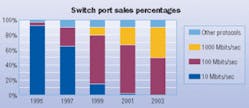Proven alien crosstalk, insertion loss results may open door to high-performance design with augmented Category 6.
For as long as UTP cables have existed, so has the desire and need to improve them in terms of speed, data-rate progression, and reduction of crosstalk.
We have seen an evolution in cabling from Category 1 to Category 6. Recent developments in the cabling industry have pushed the envelope even further. Currently, through collaboration and correspondence between the Institute of Electrical and Electronics Engineers (IEEE, New York, NY; www.ieee.org) and the Telecommunications Industry Association (TIA, Arlington, VA; www.tiaonline.org), the TIA is developing specifications for Augmented Category 6 cabling—a system that will support the IEEE's forthcoming 10GBase-T protocol over a 100-meter channel.
While most infrastructures do not require this technology today, they will in the next five years or less. To understand the significance of UTP supporting 10-Gbit Ethernet and how the medium has evolved to this point, it is important to look back on the past 10 years.
Although UTP cables have existed in one form or another for decades, they have only been used in data communications networks for roughly 10 years. Coaxial and shielded cabling solutions, such as ThickNet, ThinNet, and IBM Type 1, were very good cables for transmitting data within LANs. But with the advent and proliferation of computer networking technologies, more and more cables occupied spaces "behind the scenes," where cables had only existed for telecommunications purposes in the past.
Telecommunications closets (they were called "closets" back then) were expanded to allow for connectivity between networking devices (hubs), servers, and workstation terminals. Data rates ranged from 1 to 16 Mbits/sec and ran on proprietary cabling solutions. Several protocols existed for networks, from proprietary to somewhat standardized, such as Token Ring, Integrated Services Digital Network (ISDN), and Asynchronous Transfer Mode (ATM).
Why UTP?
Space, time, and cost constraints led to the development of a more effective UTP medium for transmitting data. By eliminating the need for shielded solutions, the end user needed less space for installation, and could reduce the cost of material and time of installation. Grounding issues also were mitigated. Most important, UTP solutions are now used as a baseline interoperability medium for the most prevalent protocols.
End of the protocol war
To better understand why UTP cable has evolved from Category 1 to Category 6, we must first understand the primary driver, i.e., data rate progression. In the early 1990s, a war was raging as to which protocol would become the industry standard for LAN applications. ATM, Token Ring, and Ethernet were all in contention.
By the mid '90s, Ethernet had come out on top. It provided a highly accessible technology with an outstanding cost basis that ultimately proved to provide the quality of service needed at the right price. In addition, the progression to 100 Mbits/sec transport assured that data rates would be sufficient to support the needed bandwidth for existing and up-and-coming applications.
In 1995, 10 Mbits/sec was the largest market share holder. By 1999, 100 Mbits/sec led the market as the protocol of choice. At this time, 1,000 Mbits/sec had gained almost as much market share as the 10 Mbits/sec protocol. Last year saw the demand for 10 Mbits/sec completely disipate. Currently, the market is split between 100 Mbits/sec and 1,000 Mbits/sec, with 100 Mbits/sec quickly on the decline.
At the same time, historically, the cabling category installed has always outpaced the speed of the protocol supported. For example, in 1995, the primary UTP cabling being installed was Category 5, which would support 100 Mbits/sec; but the switch ports sold that same year were primarily 10 Mbits/sec. In 1999, the primary switch port speed sold was 100 Mbits/sec, but the primary cabling solutions, Category 5e and Category 6, supported 1,000 Mbits/sec.
What these marketing data tell us is that the cabling installed always leads the primary data rate. This was the case until last year. Today, our fastest data rate is 1,000 Mbits/sec over UTP. The cabling being sold today is only capable of supporting 1,000 Mbits/sec. Customers will want a cabling solution that will support the next generation leap in data transmission—10 Gbits/sec.
Meeting expectations?
Originally, Category 6 was developed to support a more cost-effective way of running 1,000 Mbits/sec, by using two pairs within the cable instead of all four. This is the same way we currently run 100Base-TX, and the reason that 100Base-T4 never caught on. This approach would cut the cost of transceivers within the active hardware.
At the time, a leader in the telecommunications industry was developing the hardware/protocol in question and needed a cable that would extend the frequency bandwidth used, from the current maximum of 100 MHz out to 250 MHz, allowing for higher bandwidth potential.
Simultaneously, the development of four-pair transceivers using PAM5 encoding supported 1000Base-T (Gigabit Ethernet) over Category 5e cables. These transceivers weren't as costly as initially expected. Today, we see workstation PCs shipped with 10/100/1000Base-T network interface cards (NICs) integrated directly on motherboards. Switch prices have come down substantially, and copper is the cheapest way to run gigabit speeds within the LAN.
1000Base-T transmission was being embraced as the latest, greatest protocol technology. Both Category 5e and Category 6 cables were being sold to support it. That's right—Category 5e and Category 6 both support up to 1000Base-T transmission protocol.
An argument has been made for installing Category 6 over 5e. Category 6 does give a much better signal-to-noise ratio (SNR) than 5e, at all frequencies. This performance allows for anomalies within the active hardware that might otherwise cause a greater number of errors on a lesser-performing Category 5e cabling system. Category 6 does support broadband video applications to a greater; however, Category 6 doesn't support any protocols not already supported by 5e.
The extended frequency to 250 MHz also gave the customer a certain level of "futureproofing"—or did it? The industry seemed to adopt Category 6 with an attitude of "build it and the protocol will come." Category 6 has since been ratified by the TIA; and now that the cable has been standardized, the question still remains, "Did it meet expectations?"
What is the next leap?
First, we must understand who drives the need for a better cable. The active hardware manufacturers are key to understanding where the cable needs to go. The TIA must then respond by supporting the IEEE with a cabling standard.
Each leap in Ethernet has meant a tenfold increase in data transmission throughput (i.e., 10, 100, 1,000 Mbits/sec). The next logical step would then be to meet 10 Gbits/sec, which is already supported by fiber. The IEEE P802.3 10GBase-T study group was then formed to investigate ways of running the new transmission speeds.
Through interaction with active hardware manufacturers, however, it quickly became evident that Category 5e wasn't going to support the needed electrical requirements for the distance. Category 6, it turns out, didn't make the grade either. We've been marketing a product to a ratified TIA standard, but with no real IEEE requirements.
Category 6's electrical characteristics are tuned to a knife's edge, to say the least, yet it still couldn't support Gigabit Ethernet—the next wave of transmission—to the desired 100-meter distance. While the IEEE.P802.3 study group is looking at limited length runs for Cat 6 to support 10-Gbit Ethernet up to 55 meters, that's a far cry from the sought-after 100-meter mark.
All along, we thought that the pair-to-pair relationship within the cable was paramount to making good cable. Then came the "A" word: alien crosstalk—the noise heard on a pair within a cable, generated by another cable directly adjacent to it. The "active" community is worried about random events or events that are unpredictable. While the noise between pairs within a cable can be predicted and eliminated within the active hardware, unpredictable alien crosstalk cannot.
In search of a spitfire UTP
This raised the bar yet again, but this time for a reason. The actives now need a better cable. With limits established, testing commenced to understand what is needed from the UTP realm to achieve the goal of 10-Gbit Ethernet transmission over 100 meters.
At last November's meeting of the IEEE P802.3 10GBase-T working group, my company presented results of an augmented Category 6 cable that achieves the performance necessary to support 10-Gbit Ethernet all the way to 100 meters. A key active hardware manufacturer has confirmed those findings. Alien crosstalk performance can now be achieved, as well as the needed insertion loss levels, for transmission over the full-length requirement.
Now that it has been shown that a UTP cable and connectivity can achieve the needed electrical parameters, the active hardware manufacturers can develop their components/protocols. Copper will again support LANs to the next level of transmission performance and match the current highest speed offered by fiber. LANs will once again be ready today for the protocol of tomorrow.
Supporting the future
The development of a true 100-meter, 10-Gbit Ethernet-ready UTP system gives consumers three options: install Category 5e–a cabling solution that support's today's protocols; implement tomorrow's protocol, 10-Gbit Ethernet, to a length of 55 meters by using Category 6; or support tomorrow's protocol to the full 100 meters with augmented Category 6.
Bob Kenny is chief operating officer of Krone Inc. (www.krone.com).




